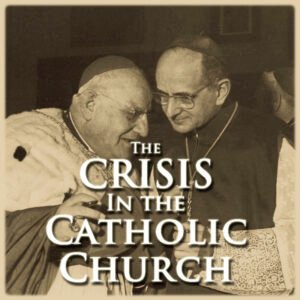(Spring 1972)
by Howard J. Earp
“THE MASS”: It is the Mass that matters; lt is the Mass that is the heart of our Catholic Faith. The Catholic religion rises and falls with this, its central act of worship. If the meaning of the Mass were to change, the religion would change. The Modernists did not institute the Novus Ordo Missae, or the New Order of the Mass, overnight it came about by a series of changes, beginning with the insertion of the name of St. Joseph into the Canon of the Mass. As the following articles demonstrate, this was nothing more than a way to get a “foot in the door” to initiate a complete rewrite of the Mass. The venerable Roman Canon was relegated to the status of being one of four “Eucharistic prayers,” thereby stripped of the very meaning of “Canon” – an unchanging, fixed rule. Although the General Instruction on the New Mass mentions, somewhat in passing, that the sacrifice is one of “praiseand thanksgiving, of reconciliation and expiation” (no. 2), nevertheless, the emphasis is on the meal, not on the Sacrifice of the Cross. In accordance with traditional Catholic sacramental theology, the Novus Ordo Missae is of doubtful validity in the original Latin. Nowhere In this New Mass is there a clear expression of a sacrifice of propitiation (atonement for sin). It is certainly invalid in the vernacular because of the change in the words of consecration from “many” to “all.”
One hundred and fifty years ago marked the beginning of a movement which had as its goal the insertion of the name of St. Joseph in the Mass liturgy. Since that time the proposal has been rejected by seven different Pontiffs. In 1962 John XXIII initiated the first change in the Canon of the Mass by inserting into it the name of St. Joseph.
In 1814 the Holy See was petitioned to add the name of St. Joseph to the list of Saints in the Communicantes prayer of the Canon of the Mass. The request was summarily denied by the Sacred Congregation of Rites in September 1815: “Negative quo ad additionem nominis S. Josephi Sponsi, B.V.M. in Canone,” thus closing the matter.
Fifty years later in 1866, the question of giving St. Joseph greater honor and higher rank in the liturgy was again proposed. A petition for this very purpose, signed by two hundred fifty-five members of the hierarchy, was presented to the Vatican Council in 1870, requesting that St. Joseph be granted the public cultus of dulia in the Sacred Liturgy.
While Pius IX on December 8, 1870, did declare St. Joseph “Patron of the Universal Church,” a title also the subject of the petitions, he made no pronouncement granting the higher rank in the liturgy (requested) for St. Joseph.
On August 15, 1892, the Congregation of Sacred Rites openly rejected the above mentioned petitions and revealed that Pope Leo XIII was opposed to the suggested revisions: “From all sides petitions have been sent to the Apostolic See, asking that St. Joseph be honored in the Sacred Liturgy with a cultus of higher rank. His Holiness (Leo XIII) nevertheless does not think fit to bestow on the Holy Patriarch a higher liturgical cultus which would alter the status wisely established in the Church throughout a long period of time.”
This movement was perhaps not recognized for what it really was until 1907, when Pius X issued his famous Encyclical on the errors of the Modernists, condemning Modernism as the” synthesis of all heresies.” St. Pius X describes Modernists as believing in the spirit of change, possessing unchecked passion for novelty, advocating that worship is subject to evolution, preaching the imperfection of Divine Revelation and harboring a want of respect for authority. He finds them audacious, proud and overzealous in accomplishing their purpose.
When considering the abovementioned movement in this light, we find it conformed to the heresy of Modernism.
The initiators of the effort were few in number; however, the sparsity of numbers was compensated for by their zeal and persistence. Within a relatively short period of time, they enjoyed widespread influence.
In 1887, one C. Mariani, a professor of theology, championed the movement of this petition, supported it with a theological analysis of the titles of St. Joseph, and proceeded to circulate it among nine hundred prelates. He claimed that two-thirds of the prelates supported his postulate. In 1892, when Pope Leo XIII expressed his disapproval of the proposed change, Mariani discontinued his efforts temporarily to await a more propitious moment.
In 1908 during the reign of Pope Pius X, Mariani felt the time had arrived. He issued his petition in the form of a booklet entitled, “…Advancing the Cultus of St. Joseph, Spouse of the Virgin Mary and Parent of Christ…” This petition was signed by more than nine hundred, among them Cardinals, bishops and superiors-general and confirmed by theological theses. The book specifically requested that “the venerable name of Joseph, as the supreme Patron of the Universal Church, second to the Mother of God, be invoked at the Confiteor, the Offertory, the Canon and the Communion of the Mass.”
Despite the numerous and prominent petitioners, the pompous title and thirty-one” confirmed … theological theses” of this book, Pope Pius X did not bless the petition with his approval.
Thus the early history of efforts to make this change in the Sacred Liturgy of the Mass clearly reveals the mind of the Church in its regard. Holy Mother the Church, guided by the light of the Holy Ghost, remained firm in her rejection of this petition from 1814 until 1914. During later years under the reign of Popes Benedict XV, Pius XI, and Pius XII, the effort met with no success.
The Popes throughout this period were zealous to increase the honor and veneration given St. Joseph, as confirmed by their acts to increase the solemnity of feasts, to invoke his name in the prayers after Mass (ordered by Pope Leo XIII in 1884), to approve with indulgences the Litany of St. Joseph (1909) to include the words, “Blessed by St. Joseph, her most chaste spouse,” in the Divine Praises (1921), by naming him as Patron in the battle against atheistic Communism (Encyclical of Pope Pius XI in 1937), by writing encyclicals promoting devotion to St. Joseph (Quamquam Plures in 1889, Acta Sanctae Sedis in 1892, and by the Motu Proprio on St. Joseph and labor); by commemorating the 50th Anniversary of St. Joseph’s declaration as Patron of the Universal Church (Pope Benedict XV in 1920), and many other subsequent acts. But these acts did not touch the heart of the Sacred Liturgy, and the prayers of the Holy Sacrifice of the Mass remain unchanged as they had been irrevocably cast in their Latin “pristine” form in 1571 by Pope St. Pius V in his solemn Bull Quo Primum.

Archive of the Roman Church, Public domain, via Wikimedia Commons
What an obvious contradiction to the past teachings of the Church is John XXIII’s sanction of the insertion of St. Joseph’s name into the Canon of the Mass on December 8, 1962! The immediate circumstances surrounding this change became lost in the tidal wave of intense innovation that followed. During the First Session of Vatican II, Bishop Cule of Yugoslavia spoke in a nervously repetitious manner and at great length promoted the insertion of St. Joseph’s name into the Mass. During this speech murmurs were heard among the delegates. Bishop Cule’s speech was cut short by a microphone interjection by Cardinal Ruffini. John XXIII was following the talk via closed-circuit television. Being a personal friend of the bishop, he was aware that his nervous manner was a tragic aftermath of Communist cruelties and persecution. Bishop Cule displayed a type of heroism in attending the session to plead the cause of St. Joseph in spite of failing health. His tragic background, affectations, and poor health illicited sympathy from John XXIII and were, no doubt, greatly responsible for the resulting grant of the request. The change in the vernacular missalette in the pews for the laity became matter-of-factly, “We honor Joseph, her husband,” where formerly the actual change, the insertion of the Latin words, “et beati Joseph eiusdeum Virginis Sponsi” (and of Blessed Joseph, Spouse of the same Virgin), appeared only hand-printed in the altar Roman Missal in the margin of the Communicantes prayer.
Was the goal of this change, which appeared so simple and praiseworthy, truly to give greater honor to the humble St. Joseph? It soon became evident that this deceptive campaign of over 150 years was, instead, promoted by liturgical innovators conforming to Modernism whose intention was, in fact, to break the immutable fixation of the Canon of the Mass. This initial change was but the opening wedge through which other changes rapidly issued. Through this wedge the ultimate in change was vomited forth- the Novus Ordo of Paul VJ in substitution for the Tridentine Mass. The Mass is no longer officially defined from the Vatican as a Sacrifice, but as “a meeting together of the People of God, presided over by the priest or president, to celebrate the memorial of the Lord.”
The campaign to give greater liturgical honor to St. Joseph fell into oblivion once the Canon of the Mass had been annihilated. Nowhere does his name again appear in the ensuing kaleidoscopic innovations from that time until this.
–Taken from the Reign of Mary Quarterly Magazine, Issue 100



